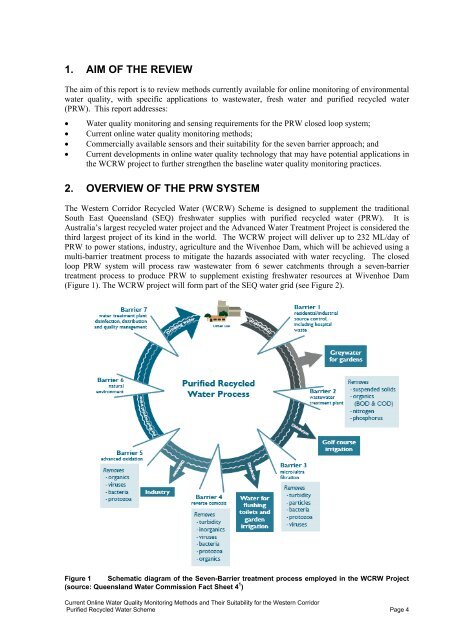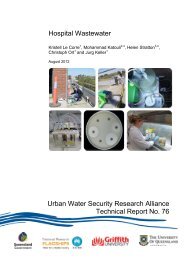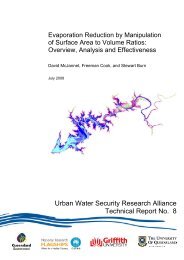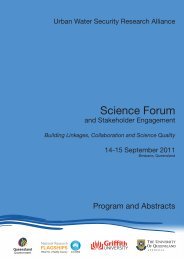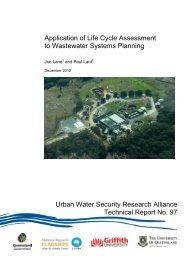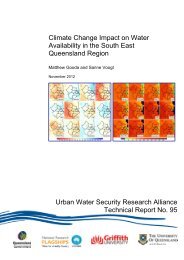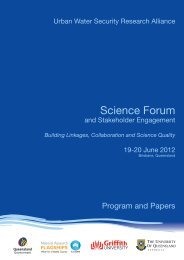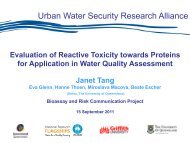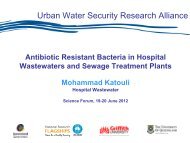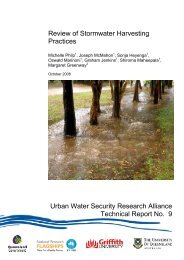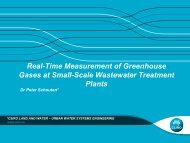Current online water quality monitoring methods and their suitability ...
Current online water quality monitoring methods and their suitability ...
Current online water quality monitoring methods and their suitability ...
You also want an ePaper? Increase the reach of your titles
YUMPU automatically turns print PDFs into web optimized ePapers that Google loves.
1. AIM OF THE REVIEWThe aim of this report is to review <strong>methods</strong> currently available for <strong>online</strong> <strong>monitoring</strong> of environmental<strong>water</strong> <strong>quality</strong>, with specific applications to waste<strong>water</strong>, fresh <strong>water</strong> <strong>and</strong> purified recycled <strong>water</strong>(PRW). This report addresses: Water <strong>quality</strong> <strong>monitoring</strong> <strong>and</strong> sensing requirements for the PRW closed loop system; <strong>Current</strong> <strong>online</strong> <strong>water</strong> <strong>quality</strong> <strong>monitoring</strong> <strong>methods</strong>;Commercially available sensors <strong>and</strong> <strong>their</strong> <strong>suitability</strong> for the seven barrier approach; <strong>and</strong><strong>Current</strong> developments in <strong>online</strong> <strong>water</strong> <strong>quality</strong> technology that may have potential applications inthe WCRW project to further strengthen the baseline <strong>water</strong> <strong>quality</strong> <strong>monitoring</strong> practices.2. OVERVIEW OF THE PRW SYSTEMThe Western Corridor Recycled Water (WCRW) Scheme is designed to supplement the traditionalSouth East Queensl<strong>and</strong> (SEQ) fresh<strong>water</strong> supplies with purified recycled <strong>water</strong> (PRW). It isAustralia’s largest recycled <strong>water</strong> project <strong>and</strong> the Advanced Water Treatment Project is considered thethird largest project of its kind in the world. The WCRW project will deliver up to 232 ML/day ofPRW to power stations, industry, agriculture <strong>and</strong> the Wivenhoe Dam, which will be achieved using amulti-barrier treatment process to mitigate the hazards associated with <strong>water</strong> recycling. The closedloop PRW system will process raw waste<strong>water</strong> from 6 sewer catchments through a seven-barriertreatment process to produce PRW to supplement existing fresh<strong>water</strong> resources at Wivenhoe Dam(Figure 1). The WCRW project will form part of the SEQ <strong>water</strong> grid (see Figure 2).Figure 1 Schematic diagram of the Seven-Barrier treatment process employed in the WCRW Project(source: Queensl<strong>and</strong> Water Commission Fact Sheet 4 1 )<strong>Current</strong> Online Water Quality Monitoring Methods <strong>and</strong> Their Suitability for the Western CorridorPurified Recycled Water Scheme Page 4


